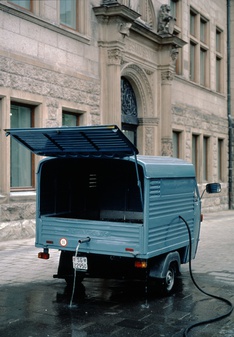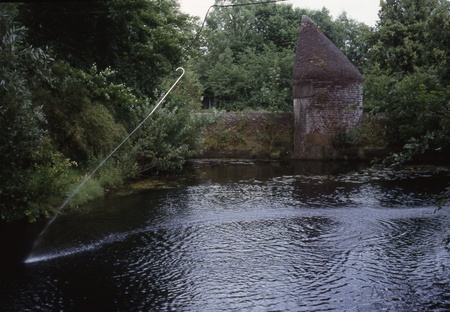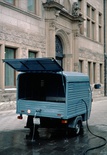Roman Signer
Fontana di Piaggio [Piaggio Fountain]
1995
Mobile installation
Modified blue panel van by vehicle manufacturer Piaggio (Ape P model), black hosepipe, water
Location
14 different inner-city locations:
Historic section of the Landesmuseum, in front of the entrance
Salzstraße in front of the Stadtmuseum
Horsteberg, north of the choir of the Cathedral
Corner of Kirchherrengasse/Mauritzstraße
Bergstraße/Kiepenkerlplatz
Pferdegasse, in front of the Fürstenberghaus
Klemensstraße, in front of the Town Hall
Corner of Drubbel/Alter Fischmarkt
Rothenburg, in front of the former Westfälisches Museum für Archäologie (today the administrative wing of the LWL-Museum für Kunst und Kultur)
Loerstraße 8, in front of the Sisters of Charity’s Euthymia Centre
Prinzipalmarkt, in front of Tepe clothes shop
Harsewinkelplatz, in front of the former “Nebengebäude K” (a regional government annex)
Ludgeristrasse
Lambertikirchplatz
Temporary installation for the duration of Skulptur. Projekte in Münster 1997
Spazierstock [Walking Stick]
1997
Kinetic installation on water
Aluminium walking stick, rope, black hosepipe, water
Height: ca. 70 cm
Location
Pond in the grounds of the former zoo behind the Westfälische Schule für Musik, Himmelreichallee 50.
Temporary installation for the duration of Skulptur. Projekte in Münster 1997
Roman Signer
* 1938 in Appenzell, Switzerland
lives and works in St. Gallen, Switzerland
In Münster in 1997 Roman Signer presented two installations connected with the element of water. Fontana di Piaggio (Piaggio Fountain), a work first conceived in 1995, consisted of an aqueous blue, three-wheeler light commercial van by the Italian vehicle-maker Piaggio. Signer repurposed the van as a mobile fountain, which over the course of Skulptur. Projekte in Münster 1997 he parked in 14 different inner-city locations, always close to a hydrant. From these hydrants, water was conducted via a hosepipe to the back of the van, where it was forced through a nozzle at pressure so that it sprayed against the tin roof in a powerful jet. The water drained out through a narrow outlet pipe in the metal-panelled back of the van and seeped away into the ground.
Signer’s second contribution, Spazierstock, was created on a pond behind the Westfälische Schule für Musik. Here the artist strung a rope across the water. Hanging from the rope was an aluminium walking stick, attached to a section of rubber hose. The hose, which was connected to the public water supply on the bank, piped water through the hollow walking stick. The pressure caused the stick to swing on the rope and vigorously spray an upside-down fountain across the surface of the pond.
Roman Signer’s artistic practice and his use of natural elements situate him within the realm of sculpture.1 In Münster he interpreted fountain design – an area traditionally close to sculpture – in a novel and whimsical manner. With Fontana di Piaggio he associated the fountain with the aspect of mobility and so created an experimental “event sculpture”2, while his Spazierstock commented upon and transformed the usually static but much-loved changing water displays in public parks.
Daniel Friedt
1 Konrad Bitterli (ed.), Roman Signer, exhib. cat. Swiss Pavilion / 48th Venice Biennale, Zurich, 1999, pp. 7–8. Fontana di Piaggio was likewise exhibited at the Biennale.
2 Cf. Susanne Jacob, “Roman Signer – WATER. Sculpture Between Experiment and Event”, in: Klaus Bussmann, Kasper König and Florian Matzner (eds.), Sculpture. Projects in Münster 1997, exhib. cat. Westfälisches Landesmuseum für Kunst und Kulturgeschichte, Münster, Ostfildern-Ruit, 1997, pp. 390–394, here p. 392.
Location
- Still existing / Public Collection
- Removed
- In the museum



